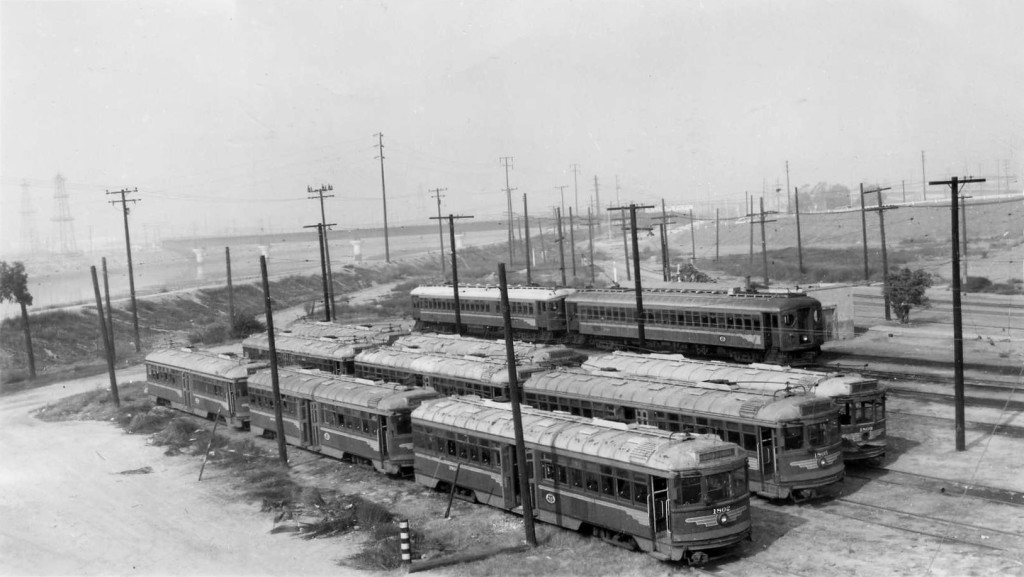Hollywood Cars at the Alamo: The Watts Line
By Ralph Cantos
As the morning sun came up over Southern California on New Years Day, January 2, 1950, the Pacific Electric did what it had done for several decades — that was, to move thousands of Angelenos heading to the Rose Parade aboard fast, comfortable, well maintained 3-car trains. About the only class of cars not heading for Pasadena that morning were the PCCs, the Echo Park 100s and the every trusty 950s.
For the remaining 1000s, all 1100s, 1200s and Blimps not needed for Southern District Holiday service schedules, and almost every serviceable Hollywood car, it “was all hands and cars on deck.” I am sure that passengers that historic morning riding comfortably aboard the cars could NEVER have imagined that this would be the last time that they would enjoy this mode of transportation to the Rose Parade.
1950 was a pivotal year for the Pacific Electric Railway and the Hollywood cars, and all the other rail cars that day. 1950 WAS “the beginning of the end” for the PE whose predominant mode of transport was by rail, and a viable passenger carrying enterprise.
Just nine short years later on New Years Day 1959, only 15 battered and neglected Hollywood cars provided service on the 7-mile Watts Local Line. Long gone were the 100s , 950s, 1000s, 1100s, and 1200s, the PCCs stored derelict inside the Subway Terminal tunnel. The once-mighty armada of 160 Hollywood cars was now down to just 15 cars, of which only 13 were serviceable. The cars were now under the ownership of the first LAMTA, an agency hell bent on total destruction of electric rail transportation in LA. The Watts line required 11 cars for the weekday rush hour service (5 two-car trains and 1 spare). And so, like the brave men at the Alamo fighting against insurmountable odds, the last Hollywood cars were over run by hordes of invading buses. It was “The Last Stand” for these wonderful, durable cars.
I took the above photo in February 1960 at Morgan Yard. The last nine Hollywood cars wait for the inevitable, the last mile to the front gates of National Metals & Steel on Terminal Island. Cars 1802, 1801, and 1809 are closest to the camera. If you look closely, the right front of 1809 has damage to the front door and dasher. When the Watts Line was abandoned in November of 1959, only ONE spare car was available to fight on; 1809 was mortally injured in a grade crossing accident just 3 months before abandonment. These fine cars had put a great fight but were done in by overwhelming odds.
Ralph Cantos Photo, Ralph Cantos Collection



Wouldn’t there have been service to Pasadena on Jan 1, 1951? The Oak Knoll line would have been gone, so there wouldn’t have been as many trains, but there should have been some extra runs. And of course Santa Anita Park was open, so there would have been Race Track Specials. By then they would have been mainly Blimps–I remember seeing trains made up of two Blimp combines and a 300-class car going by my house on the way to the east side of Monrovia for storage. I’m not positive, but I don’t think PE ever ran Blimps to Pasadena.
There was indeed service to the Rose Parade on Jan. 1, 1951. All outbound service was via San Pedro St. as Main St. trackage had been taken out of service the year before.
I stand corrected, but I am sure the rail service to the Rose Parade in 1951 was not on the scale of 1950. Buses were moving in for the kill.
Can anyone out there give an eye witness account, or have photos of PE rail operations on New Years Day 1951? With PE tracks on Main St. abandoned, 3 car Rose Parade trains could not operate through the building out on to Main St. It would have been one BIG Hell of a mess to get all those Rose Parade trains in and out of the terminal, all the while maintaining regular Southern District rail operations on the Long Beach, San Pedro, Santa Ana, and Watts Lines. I just don’t see how it could have been done. Buses must have played a major part of the Special Rose Parade passenger service that day.
The PE did run Race Track trains on New Years Day,1951. Most of the trains were made up of BLIMPS. Still not clear is just how many Rose Parade trains were operated that day, with the run through tracks out to Main St gone. Buses must have played a big part of the Special Service to the Parade.There are many photos of the Race Track trains, but little or none of the 1951 Rose Parade Special trains.
I think the car to the right of #1802 actually reads as #1803, not #1801?